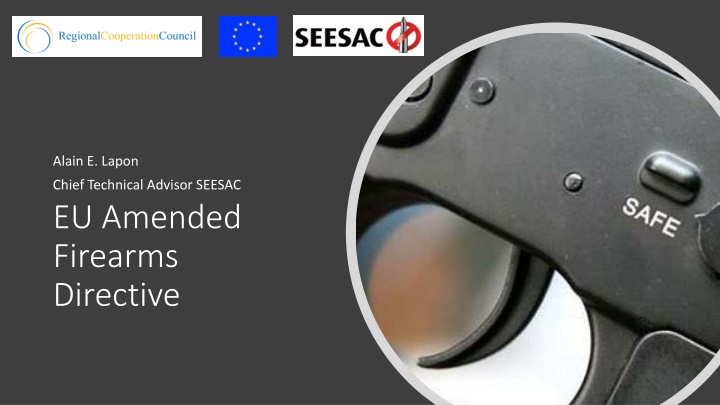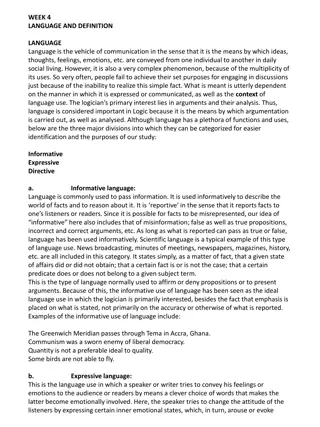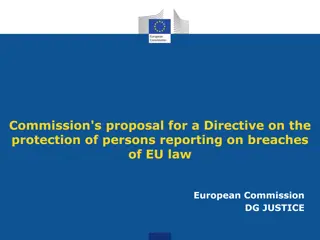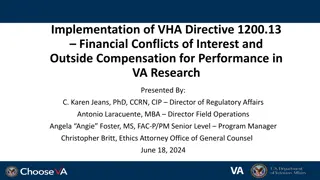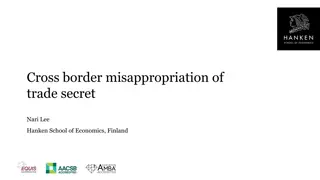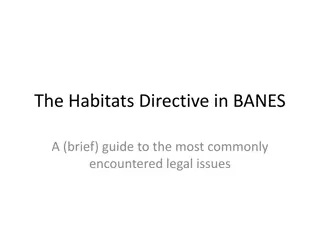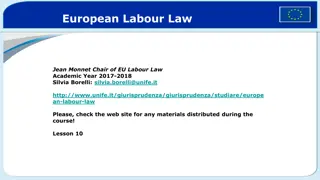Overview of Amended Firearms Directive and Stricter Regulations
The Amended Firearms Directive aims to tighten rules on semi-automatic firearms, improve online acquisitions, enhance traceability of weapons, and facilitate information exchange among EU Member States. It also introduces stricter conditions for deactivated firearms and collectors to prevent criminal sales. Additionally, the directive defines firearms and alarm/signal weapons, outlining their capabilities and restrictions.
Download Presentation

Please find below an Image/Link to download the presentation.
The content on the website is provided AS IS for your information and personal use only. It may not be sold, licensed, or shared on other websites without obtaining consent from the author.If you encounter any issues during the download, it is possible that the publisher has removed the file from their server.
You are allowed to download the files provided on this website for personal or commercial use, subject to the condition that they are used lawfully. All files are the property of their respective owners.
The content on the website is provided AS IS for your information and personal use only. It may not be sold, licensed, or shared on other websites without obtaining consent from the author.
E N D
Presentation Transcript
Alain E. Lapon Chief Technical Advisor SEESAC EU Amended Firearms Directive
History of FA directive 91/477/EEC Amendment 2008/51 Amended 2017/853
Stricter rules to ban certain semi-automatic firearms, which will not, under any circumstance, be allowed to be held by private persons, even if they have been permanently deactivated; Main Aims Tighter rules on the online acquisition of firearms, to avoid the acquisition of firearms, key parts or ammunition through the Internet; EU common rules on marking of firearms to improve the traceability of weapons; Better exchange of information between Member States, for example on any refusal of authorisation to own a firearm decided by another national authority, and obligation to interconnect national registers of weapons; Common criteria concerning alarm weapons (e.g. distress flares and starter pistols)in order to prevent their transformation into fully functioning firearms; Stricter conditions for the circulation of deactivated firearms; Stricter conditions for collectors to limit the risk of sale to criminals.
Implementing regulations Alarm/signal weapons Deactivation Marking
Alarm/signal weapons Discussion Paper for Firearms Committee 4 April 2018 Elements of draft Commission Implementing Act on Alarm and Signal weapons
firearm means any portable barrelled weapon that expels, is designed to expel or may be converted to expel a shot, bullet or projectile by the action of a combustible propellant, unless it is excluded from that definition for one of the reasons listed in Part III of Annex I. Firearms are classified in Part II of Annex I. Definitions An object shall be considered to be capable of being converted to expel a shot, bullet or projectile by the action of a combustible propellant if: as a result of its construction or the material from which it is made, it can be so converted; it has the appearance of a firearm; and
Definitions - 2 alarm and signal weapons means devices with a cartridge holder which are designed to fire only blanks, irritants, other active substances or pyrotechnic signalling rounds and which are not capable of being converted to expel a shot, bullet or projectile by the action of a combustible propellant;
Alarm and signal weapons shall comply with the technical specifications set out in Annex I ensuring their non-convertibility to expel a shot, bullet or projectile by the action of a combustible propellant. Alarm and signal weapons not complying with these technical specifications shall be considered as firearms in accordance with Article 1.1 (1) of Directive 91/477/EEC. Scope Scope This [Regulation/Directive] shall not apply to Alarm and Signal weapons classified as firearms by Member States national legislation, unless those alarm and signal weapons are transferred to another Member State..
Alarm and Signal weapons manufactured in the EU or imported in a Member State that treat such weapons as alarm or signal weapons shall be subject to a verification of their compliance with the technical specifications set out in Annex I. 2. Any Member State may request the assistance of the entities authorised by another Member State to verify alarm and signal weapons in order to verify their compliance with the technical specifications set out in Annex I. Verification of the non Verification of the non- - convertibility of alarm convertibility of alarm and signal weapons and signal weapons
Member States may introduce additional measures to ensure the non- convertibility of alarm and signal weapons on their territory going beyond the technical specifications set out in Annex I. The Commission shall regularly assess, with the Committee established by Directive 91/477/EEC as amended by Directive (EU) 2017/853, any additional measure taken by the Member States and shall consider revising the technical specifications set out in Annex I in due time. Additional measures for Additional measures for the non the non- -convertibility of convertibility of alarm and signal weapons alarm and signal weapons
Member States shall notify to the Commission any measures they adopt in the field covered by this Regulation as well as any additional measure. Notification requirements Notification requirements
Member States may introduce additional measures to ensure the non- convertibility of alarm and signal weapons on their territory going beyond the technical specifications set out in Annex I. The Commission shall regularly assess, with the Committee established by Directive 91/477/EEC as amended by Directive (EU) 2017/853, any additional measure taken by the Member States and shall consider revising the technical specifications set out in Annex I in due time. Additional measures for Additional measures for the non the non- -convertibility of convertibility of alarm and signal weapons alarm and signal weapons
Alarm and signal weapons manufactured or imported into the European Union shall comply with the following technical specifications: are only capable of firing blanks, firing irritants or other active substances, are only capable of shooting pyrotechnic signalling rounds if an adaptor at the muzzle is attached; have a durable device within the weapon to prevent the firing of cartridges loaded with single or multiple solid projectiles; have a cartridge chamber only suitable for firing blank ammunition exclusively listed in table VIII of the Tables of Dimensions of Cartridges and Chambers (TDCC) established by the Permanent International Commission for the Proof of Small Arms (C.I.P.) and in effect at the time of entry into force of this Directive. Technical Specifications Technical Specifications
Alarm and signal weapons must be built or constructed in such a manner that they cannot be modified through use of ordinary tools. All essential components of alarm and signal weapons must be incompatible with essential components of (active) firearms as defined in Article 1 (2) of Directive 91/477/EEC on control of the acquisition and possession of weapons. Barrels of alarm and signal weapons must be designed or constructed in a manner that it cannot be removed or modified without damaging and/or destroying the weapon. Technical Specifications Technical Specifications - - 2 2
Short alarm and signal weapons must incorporate irremovable barriers along the full length of the barrel, leaving a maximum free space of 1 cm at the muzzle. Short weapon means a weapon with a barrel not exceeding 30 centimetres or whose overall length does not exceed 60 centimetres. Long alarm and signal weapons must incorporate irremovable barriers on at least one third of the barrel length, leaving a maximum free space of 1 cm at the muzzle, so that a projectile is not able to pass through the barrel. Long weapon means any weapon other than a short alarm or signal weapon. In both long and short alarm and signal weapons, the first barrier in the barrel must be placed just after the chamber of the weapon. Technical Specifications Technical Specifications - - 3 3
Barriers shall be permanent and incapable of being knocked out without destroying the chamber or barrel. For alarm and signal weapons intended to fire only blanks, barriers must wholly block the barrel apart from at least two exit holes for the gas pressure that must be at right angles to the axis of the barrel, and point away from each other. Barriers must be wholly made of a material which is at least as resistant to being cut, drilled, bored, ground (or any similar process) as sintered tungsten carbide in the range 1550-2000 HV 30. Barriers must wholly block the barrel so that no gas can be fired from the front of the weapon Technical Specifications Technical Specifications 3b 3b
- For alarm and signal weapons intended to fire both blanks and irritants, barriers must be made of a suitable material ensuring that a projectile is not able to pass through the barrel. A barrel may have a channel along its axis to enable irritants being expelled out of the weapon. In either case barriers must be designed to prevent: - The creation or enlargement of a hole through the barrel along its axis; and - The removal of the barrel, unless the frame and chamber area of the alarm and signal weapon is rendered useless as a result or its integrity so compromised that it cannot be used to form the basis of a firearm without significant repair or addition. Technical Specifications Technical Specifications 3c 3c
Blank chambers and barrel must be offset or tilted or staggered to avoid live ammunition to be loaded in the alarm/signal weapons. In addition for revolver type of weapons: Cylinder chamber opening must be narrowed to ensure bullets are stuck into the chamber. The opening must be offset to the chamber. Technical Specifications Technical Specifications - - 4 4
II. To take into account technical developments of alarm and signal weapons convertibility over time, these technical specifications will be reviewed and updated on a regular basis, at the latest every X years. Technical Specifications Technical Specifications - - 5 5
